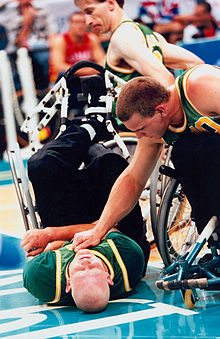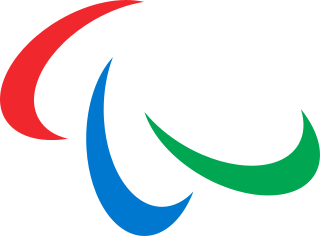
The Summer Paralympics also known as the Games of the Paralympiad, are an international multi-sport event where athletes with physical disabilities compete. This includes athletes with mobility disabilities, amputations, blindness, and cerebral palsy. The Paralympic Games are held every four years, organized by the International Paralympic Committee. Medals are awarded in each event, with gold medals for first place, silver for second and bronze for third, a tradition that the Olympic Games started in 1904.
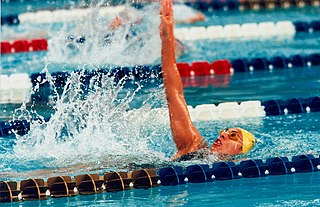
S8, SB7, SM8 are disability swimming classifications used for categorizing swimmers based on their level of disability. This class includes a number of different disabilities including people with amputations and cerebral palsy. The classification is governed by the International Paralympic Committee, and competes at the Paralympic Games.
S10, SB9, SM10 are disability swimming classifications used for categorizing swimmers based on their level of disability. Swimmers in this class tend to have minimal weakness affecting their legs, missing feet, a missing leg below the knee or problems with their hips. This class includes a number of different disabilities including people with amputations and cerebral palsy. The classification is governed by the International Paralympic Committee, and competes at the Paralympic Games.

2 point player and 2.5 point player is a disability sport classification for wheelchair basketball. People in this class have partial trunk control when making forward motions. The class includes people with T8-L1 paraplegia, post-polio paralysis and amputations. People in this class handle the ball less than higher-point players. They have some stability issues on court, and may hold their wheel when trying to one hand grab rebounds.
3 point player is a disability sport classification for wheelchair basketball. People in this class have good forward and backward trunk movement but poor to no sideways trunk movement. The class includes people with L2-L4 paraplegia and amputations. Amputees are put into this class generally if they have hip disarticulations or hip abductions. Players in this class can generally rebound balls that are over their heads, but they can have some issues with balance during lateral rebounds.
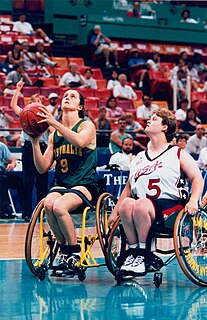
4 point player is a disability sport classification for wheelchair basketball. Players in this class have normal trunk function but have a reduced level of functioning in one or both of their lower limbs. They may have difficulty with sideways movements. People in this class include ISOD classified A1, A2 and A3 players.
T42 is a disability sport classification for disability athletics, applying to athletes with single above the knee amputations or a disability that is comparable. This class includes ISOD classified A2 and A9 competitors.
T43 is a disability sport classification for disability athletics, applying to athletes with "Double below knee amputation or similar disability." It includes ISOD classified athletes from the A4 and A9 classes.
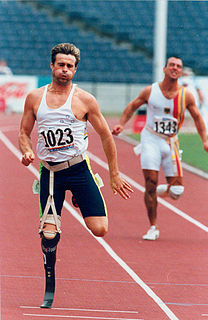
T44 is a disability sport classification for disability athletics, applying to "Single below knee amputation or an athlete who can walk with moderately reduced function in one or both legs." It includes ISOD A4 and A9 classes.
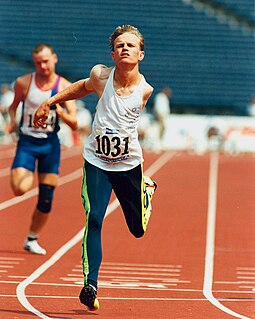
T46 and F46 are disability sport classification for disability athletics. People in this class have a single below or above the elbow amputation. The amputee sports equivalent class is ISOD the A6 and A8 classes. People in this class can have injuries as a result of over use of their remaining upper limb. The classification process to be included in this class has four parts: a medical exam, observation during training, observation during competition and then being classified into this class.
Disability sports classification is a system that allows for fair competition between people with different types of disabilities.
Paratriathlon classification is the classification system for athletes participating in paratriathlon. It is governed by the World Triathlon The sport has been included in the 2016 Summer Paralympics.
F56 is a disability sport classification for disability athletics for people who compete in field events from a seated position. The seating field event class used to be known as lower 4, upper 5. Different disability groups compete in this class, including people with amputations and spinal cord injuries. Events that may be on the program for F56 competitors include the discus throw, shot put and javelin.
Amputee sports classification is a disability specific sport classification used for disability sports to facilitate fair competition among people with different types of amputations. This classification was set up by International Sports Organization for the Disabled (ISOD), and is currently managed by IWAS who ISOD merged with in 2005. Several sports have sport specific governing bodies managing classification for amputee sportspeople.
A2 is an amputee sport classification used by the International Sports Organization for the Disabled (ISOD).for people with acquired or congenital amputations. A2 sportspeople have one leg amputated above the knee. Their amputations impact their sport performance, including having balance issues, increased energy costs, higher rates of oxygen consumption, and issues with their gait.
A3 is an amputee sport classification used by the International Sports Organization for the Disabled (ISOD) for people with acquired or congenital amputations. A3 classified sportspeople have both legs amputated below knee. Their amputations impact their sport performance, including having balance issues, increased energy costs, higher rates of oxygen consumption, and issues with their gait. Sports people in this class are eligible to participate in include athletics, swimming, sitting volleyball, archery, weightlifting, badminton, lawn bowls, sitzball and wheelchair basketball.
A4 is an amputee sport classification used by the International Sports Organization for the Disabled (ISOD).for people with acquired or congenital amputations. People in this class have one leg amputated below the knee. Their amputations impact their sport performance, including having balance issues, increased energy costs, higher rates of oxygen consumption, and issues with their gait. Sports people in this class are eligible to participate in include athletics, swimming, sitting volleyball, archery, weightlifting, wheelchair basketball, amputee basketball, amputee football, lawn bowls, and sitzball.
A6 is an amputee sport classification used by the International Sports Organization for the Disabled (ISOD) for people with acquired or congenital amputations. People in this class have one arm amputated above or through the elbow joint. Their amputations impact their sport performance, including being more prone to overuse injuries. Sports people in this class are eligible to participate in include athletics, swimming, cycling, amputee basketball, amputee football, lawn bowls, and sitzball.
A9 is an amputee sport classification used by the International Sports Organization for the Disabled (ISOD).for people with acquired or congenital amputations. People in this class have combination of amputations of the upper and lower extremities. Their amputations impact their sport performance, including energy costs, balance and potential for overuse of muscles. Sports people in this class are eligible to participate in include athletics, swimming, sitting volleyball, amputee basketball, lawn bowls, sitzball and wheelchair basketball.
A1 is an amputee sport classification used by the International Sports Organization for the Disabled (ISOD) for people with acquired or congenital amputations. This class is for sportspeople who have both legs amputated above the knee. Their amputations impact their sport performance, including having balance issues, increased energy costs, higher rates of oxygen consumption, and issues with their gait. Sports people in this class are eligible to participate in include athletics, swimming, sitting volleyball, archery, weightlifting, badminton, lawn bowls, sitzball and wheelchair basketball.
